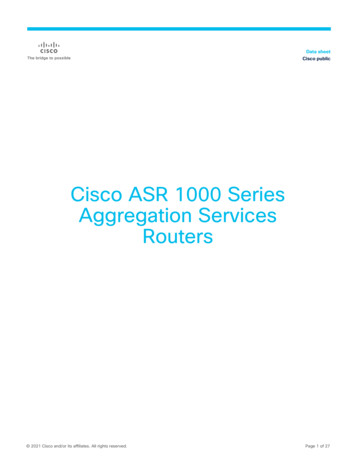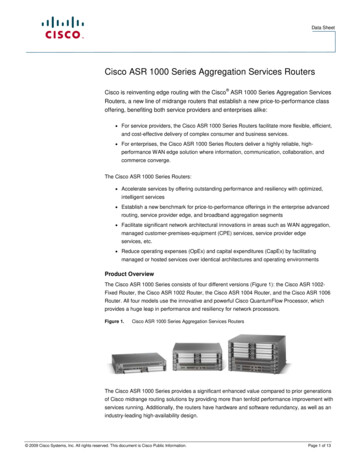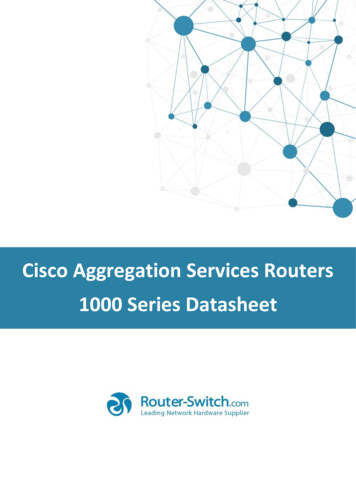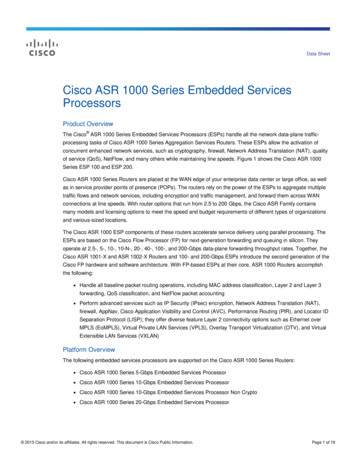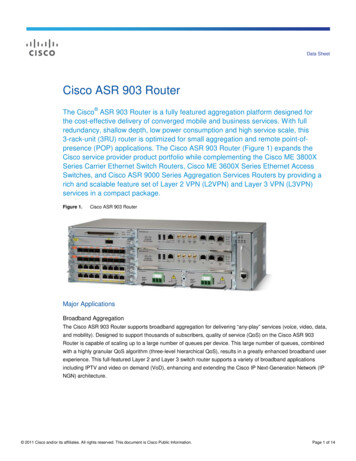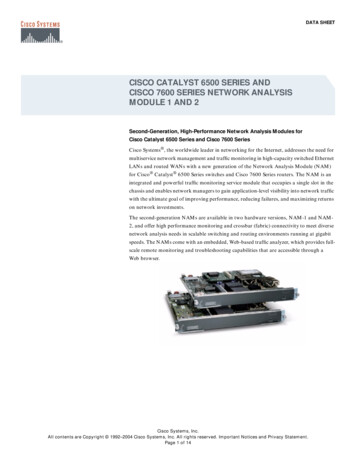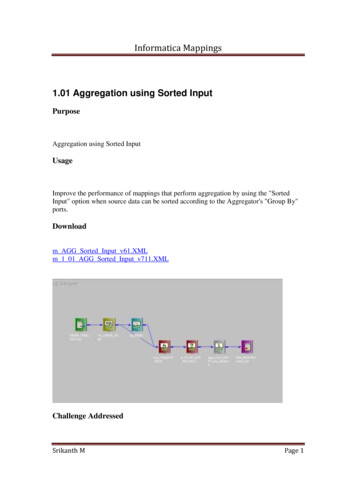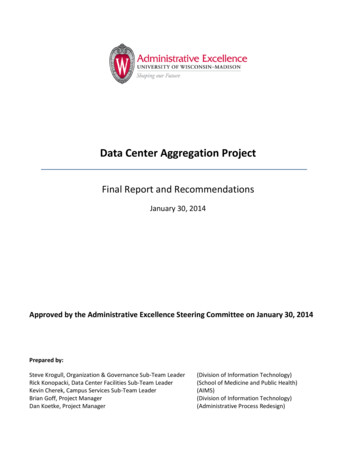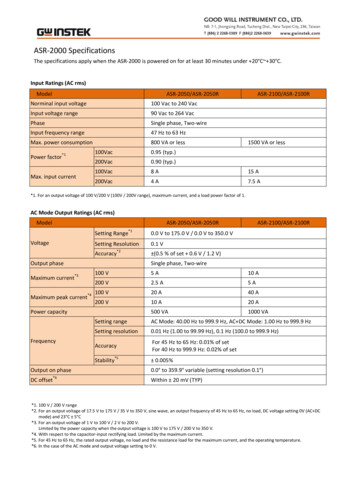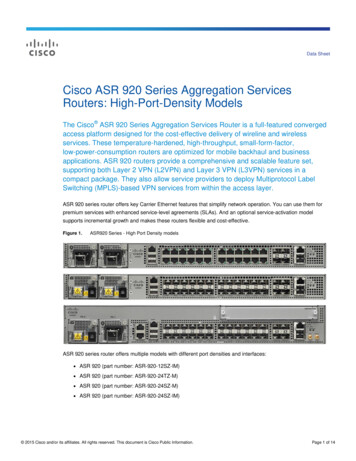
Transcription
Data SheetCisco ASR 920 Series Aggregation ServicesRouters: High-Port-Density ModelsThe Cisco ASR 920 Series Aggregation Services Router is a full-featured convergedaccess platform designed for the cost-effective delivery of wireline and wirelessservices. These temperature-hardened, high-throughput, small-form-factor,low-power-consumption routers are optimized for mobile backhaul and businessapplications. ASR 920 routers provide a comprehensive and scalable feature set,supporting both Layer 2 VPN (L2VPN) and Layer 3 VPN (L3VPN) services in acompact package. They also allow service providers to deploy Multiprotocol LabelSwitching (MPLS)-based VPN services from within the access layer.ASR 920 series router offers key Carrier Ethernet features that simplify network operation. You can use them forpremium services with enhanced service-level agreements (SLAs). And an optional service-activation modelsupports incremental growth and makes these routers flexible and cost-effective.Figure 1.ASR920 Series - High Port Density modelsASR 920 series router offers multiple models with different port densities and interfaces: ASR 920 (part number: ASR-920-12SZ-IM) ASR 920 (part number: ASR-920-24TZ-M) ASR 920 (part number: ASR-920-24SZ-M) ASR 920 (part number: ASR-920-24SZ-IM) 2015 Cisco and/or its affiliates. All rights reserved. This document is Cisco Public Information.Page 1 of 14
Major ApplicationsBroadband AccessCisco ASR 920 routers support broadband access for delivering “any-play” services (that is, voice, video, data, andmobility) to thousands of subscribers. Quality of service (QoS) on these routers can scale up to a large number ofqueues per device. This large number of queues, combined with a three-level hierarchical QoS algorithm, candeliver an enhanced broadband user experience. This full-featured Layer 2 switch and Layer 3 router supports avariety of broadband applications, including IPTV and video on demand (VoD), enhancing and extending the CiscoEvolved Programmable Network (EPN) architecture.Converged Access for Mobile ApplicationsDeployed as a converged access platform for mobile backhaul, the ASR 920 router can aggregate multiple basestations through multiple Ethernet and IP interfaces, and it can use MPLS as a transport for mobile backhaul traffic.It also provides the Synchronous Ethernet (SyncE) and IEEE-1588 timing services required in today’s convergedaccess networks. The model (ASR-920-12SZ-IM) has a built-in GNSS receiver, which can act as a grandmasterclock for aggregating and backhauling small cell traffic. It also supports Cisco Universal Power over Ethernet(Cisco UPOE ) which can be used to power small cell radios. The router can be deployed in small, completelysealed cabinets in outside environments, because of its small form factor and its durability in extended temperatureranges.Advanced SecuritySmall cells deployments face challenges on the security front due to their location. The model (ASR-920-12SZ-IM)supports security services such as IP Security (IPSec), Network Address Translation (NAT), and Port AddressTranslation (PAT) to help protect against vulnerabilities to subscriber traffic and the network. A built-in hardwarecrypto engine allows the feature to scale and makes it ideal for extensive small cell deployments.Metro Ethernet AccessThe Cisco ASR 920 router is built to meet service provider requirements for Carrier Ethernet access. It is optimizedfor remote access and central offices, for smaller aggregation sites where a full-featured, small-footprint convergedplatform is needed. The router offers service flexibility and delivers Layer 2, IP, and MPLS transport for advancedL2VPN, L3VPN, and multicast services.Major DifferentiatorsASR 920 routers help service providers deliver differentiated, cost-effective services such as residentialbroadband, mobile, and Metro Ethernet.Flexible Deployment OptionsASR 920 routers are designed with a 1RU compact form factor to accommodate deployment in small spaces. ASR920-24SZ-IM model is 1.5RU to accommodate the interface module in the chassis. Available with a range ofmounting options, these routers can be deployed in space-constrained locations such as ETSI 300-mm-deepcabinets. The extended temperature range supported by ASR 920 router allows them to be deployed in locationswith minimal environmental control. In addition, their small footprint allows service providers to extend the reach oftheir Carrier Ethernet networks to more challenging and remote locations. 2015 Cisco and/or its affiliates. All rights reserved. This document is Cisco Public Information.Page 2 of 14
Power-Supply Unit: High AvailabilityASR 920 routers offer a choice of AC and DC power supplies, which are redundant and built into the chassis.Ethernet interfaces are available in copper and fiber, with speeds ranging from 10 Mbps to 10 Gbps.The time-division multiplexing (TDM) interfaces are available in the product models (ASR-920-12SZ-IM andASR-920-24SZ-IM), with speeds ranging from n x DS-0 to OC-12/STM-4 for plesiochronous digital hierarchy(PDH), SDH, and SONET. The interface modules, power supplies, and fan tray are all field-replaceable.Powered by the Cisco Carrier Ethernet ASICPowered by the Cisco Carrier Ethernet application-specific integrated circuit (ASIC), which was designedspecifically for service providers, ASR 920 routers deliver essential Carrier Ethernet technologies, includinghierarchical quality of service (HQoS), MPLS, and Virtual Private LAN Services (VPLS). This custom and advancedASIC design provides uninterrupted line-rate performance while delivering complex services such as accesscontrol list (ACL) and HQoS. The Carrier Ethernet ASIC integrates Cisco traffic-management innovation to deliverintelligent packet-switching and routing operations.Service EnhancementIn ASR 920 routers, each service is assigned enhanced QoS and security attributes. The router provides advancedper-traffic-class metering and offers bidirectional packet-count and byte-count statistics. The service offering isenhanced with operations, administration, and maintenance (OAM) functions that include Layer 2 ConnectivityFault Management (CFM), IP service-level agreements (SLAs) for Layer 3, and MPLS OAM.BenefitsMPLS in the Access LayerCisco ASR 920 routers extend MPLS into the access layer by allowing service providers to initiate MPLS-basedLayer 2 and Layer 3 VPN services from within the access layer. These routers give service providers the ability toexpand MPLS toward their network edge to gain the advantages of a single unified MPLS control plane acrosstheir networks. They offer full VPLS support, allowing multipoint services definition. For additional flexibility, VPLScan be deployed as a full mesh or as Hierarchical VPLS (H-VPLS).Incremental Investment ModelThe return on investment (ROI) on an access element is heavily influenced by its location in the network andproximity to customers. The ability to deploy ASR 920 routers, then activate features later, on demand, deliversinvestment protection. This protection allows flexible timing for deploying MPLS and10 Gigabit Ethernet servicesand boosting service capacity.Advanced Service-Level AgreementsService-aware QoS allows service providers to expand and differentiate their services portfolio with highlyadvanced and differentiated SLAs. The HQoS capabilities of ASR 920 routers scale to eight queues per service,three levels of scheduling, and buffer volumes capable of accommodating today's most demanding wireline andwireless applications. 2015 Cisco and/or its affiliates. All rights reserved. This document is Cisco Public Information.Page 3 of 14
Mobile Timing and Synchronization ServicesASR 920 routers provide the timing services required in a converged access network to support mobile solutions,including Radio Access Network (RAN) applications. They also support SyncE with Ethernet SynchronizationMessaging Channel (ESMC) and Synchronization Status Messages (SSM) to allow excellent clock-sourcetraceability. In addition, the routers support IEEE-1588, and the ASR-920-12SZ-IM model has a built-in GNSSreceiver which can act as a grandmaster clock for aggregating and backhauling small cell traffic.Operational Efficiency for Carrier Ethernet Access DeploymentsCisco ASR 920 routers feature major enhancements that help service providers simplify and facilitate networkmanagement, for reduced operational costs. With these innovative features, ASR 920 routers can be deployed in avariety of applications, including business services with 10-Gigabit Ethernet User Network Interface (UNI) andEthernet mobile backhaul. The features enhance performance awareness, facilitate troubleshooting, and simplifyservice turn-up and restoration."Dying gasp" for power indicators and four external alarm inputs also detectchanges in remote sites, giving service providers additional tools to manage the health of network elements.Universal Customer Premises EquipmentWith all interfaces built in, this fixed-form-factor platform is versatile and can address many deployment scenarios,including Gigabit Ethernet and 10 Gigabit Ethernet deployments. The licensing mechanism allows additional1 Gigabit and 10 Gigabit Ethernet interfaces to be activated as required for a particular deployment, so serviceproviders can customize the configuration of the device and pay only when their services grow. With support forextended temperatures, ASR 920 routers can be deployed in outside environments and remote locations.SoftwareCisco ASR 920 touters are supported in Cisco IOS XE Software, which is a modular operating system. Thissoftware is designed to provide modular packaging, feature velocity, and powerful resiliency. For more informationon the supported features and software capabilities, see the Cisco IOS XE Software for Cisco ASR 920 SeriesAggregation Services Router data sheet.Network ManagementCisco ASR 920 routers are supported in Cisco Prime for EPN architectures. The Cisco Prime end-to-end networkmanagement solution drastically simplifies the design, provisioning, and management of carrier-grade networks. Itis a comprehensive solution that centralizes and automates service design, fulfillment, assurance, andperformance analysis to help service providers and enterprises lower their costs while meeting high customerexpectations.Interface ModulesInterface modules supported on the ASR 920 routers are listed in Table 1 and Table 2.Table 1.Interface Modules Supported on Cisco ASR 920 Router - ASR-920-12SZ-IM ModelPart NumberDescriptionSupported as of Cisco IOS XE ReleaseA900-IMA8TASR 900 8 port 10/100/1000 Ethernet Interface Module3.16.0SA900-IMA8SASR 900 8 port SFP Gigabit Ethernet Interface Module3.16.0SA900-IMA8DASR 900 8 port RJ48C T1/E1 Interface Module3.16.0SA900-IMA16DASR 900 16 port T1/E1 Interface Module, Requires patch panel3.16.0SA900-IMA1XASR 900 1 port 10GE XFP Interface Module3.16.0S 2015 Cisco and/or its affiliates. All rights reserved. This document is Cisco Public Information.Page 4 of 14
Table 2.Interface Modules Supported on Cisco ASR 920 Router - ASR-920-24SZ-IM ModelPart NumberDescriptionSupported as of Cisco IOS XE ReleaseA900-IMA8TASR 900 8 port 10/100/1000 Ethernet Interface Module3.14.0SA900-IMA1XASR 900 1 port 10GE XFP Interface Module3.14.0SA900-IMA2ZASR 900 2 port 10GE SFP /XFP Interface Module3.14.0SA900-IMA8DASR 900 8 port RJ48C T1/E1 Interface Module3.14.0SA900-IMA16DASR 900 16 port T1/E1 Interface Module, Requires patch panel3.15.0SA900-IMA32DASR 900 32 port T1/E1 Interface Module, Requires patch panel3.15.0SA900-IMA4OSASR 900 4 port OC3/STM1 or 1 port OC12/STM4 Interface Module3.15.0SCisco ASR 900 Series 8-Port 1GE RJ-45 ModuleThis interface module delivers eight ports of Gigabit Ethernet, Fast Ethernet, and Ethernet connectivity on CiscoASR 920 routers. The interface speed can be software-selected per interface. This interface module providesphysical connectivity using eight RJ-45 connectors. When this module is inserted in the ASR 920 Router (ASR920-24SZ-IM model), ports 16-23 of the chassis are not usable.Cisco ASR 900 Series 8-Port 1GE SFP ModuleThis interface module delivers eight ports of Gigabit Ethernet and Fast Ethernet connectivity on ASR 920 routers.The interface speed can be selected per interface, depending on the optic used. This interface module providesphysical connectivity using eight SFP optics.Table 3 lists the pluggable optics that are supported in the Cisco ASR 900 Series 8-Port 1GE SFP Module, onCisco IOS XE Software releases for Cisco ASR 920 routers.Table 3.Pluggable Optics Supported on Cisco ASR 900 Series 8-Port 1GE SFP ModuleEthernet SFPsSupported as of ReleaseDescriptionGLC-FE-100LX3.16100BASE-LX SFP for FE portGLC-FE-100BX-D3.16100BASE-BX10-D SFPGLC-FE-100BX-U3.16100BASE-BX10-U SFPGLC-FE-100EX3.16100BASE-EX SFP (40km)GLC-FE-100ZX3.16100BASE-ZX SFP (80km)GLC-FE-100FX3.16100BASE-FX SFP for FE portGLC-FE-100LX-RGD 3.16100BASE-LX SM Rugged SFPGLC-FE-100FX-RGD 3.16100BASE-FX MM Rugged SFPGLC-SX-MM-RGD3.161000Mbps Multi-Mode Rugged SFPGLC-LX-SM-RGD3.161000Mbps Single Mode Rugged SFPGLC-ZX-SM-RGD3.161000BASE-ZX Single Mode Rugged SFPGLC-BX-D 3.161000BASE-BX SFP, 1490nmGLC-BX-U 3.161000BASE-BX SFP, 1310nmGLC-EX-SMD3.16GE SFP, LC Connector, EX transceiverGLC-SX-MMD3.161000BASE-SX SFP transceiver module, MMF, 850nm, DOMGLC-LH-SMD3.161000BASE-LX/LH SFP transceiver module, MMF/SMF, 1310nm, DOMGLC-ZX-SMD3.161000BASE-ZX SFP transceiver module, SMF, 1550nm, DOMSFP-GE-T3.161000BASE-T SFP (NEBS 3 ESD)Gigabit Ethernet SFPs 2015 Cisco and/or its affiliates. All rights reserved. This document is Cisco Public Information.Page 5 of 14
Ethernet SFPsSupported as of ReleaseDescriptionSFP-GE-L3.161000BASE-LX/LH SFP (DOM)SFP-GE-S3.161000BASE-SX SFP (DOM)SFP-GE-Z3.161000BASE-ZX Gigabit Ethernet SFP (DOM)GLC-BX40-U-I3.161000BASE-BX40 SFP, 1310NMGLC-BX40-D-I3.161000BASE-BX40 SFP, 1550NMGLC-BX40-DA-I3.161000BASE-BX40 SFP, 1490NMGLC-BX80-U-I3.1
Metro Ethernet Access The Cisco ASR 920 router is built to meet service provider requirements for Carrier Ethernet access. It is optimized for remote access and central offices, for smaller aggregation sites where a full-featured, small-footprint converged platform is needed. The router offers service flexibility and delivers Layer 2, IP, and MPLS transport for advanced
